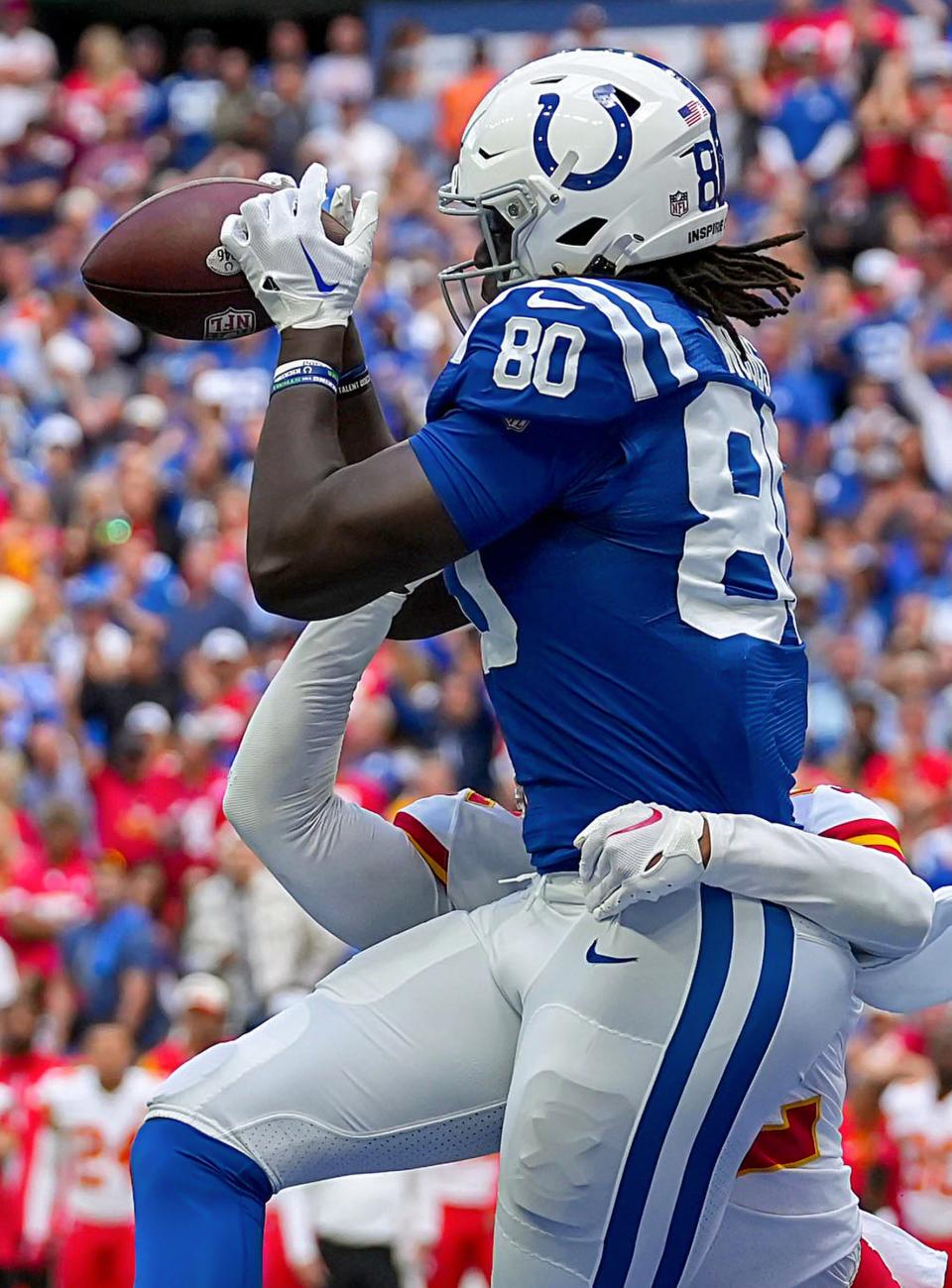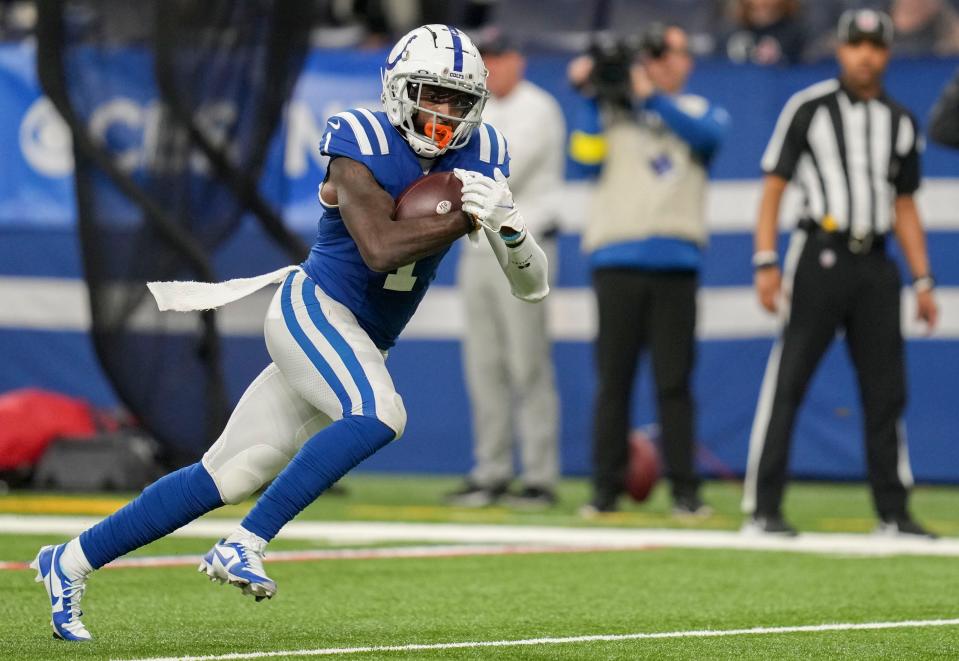The Colts are moving towards the end of their offseason practices, with two more weeks to go until they take a break for the summer. Some pieces, like the new passing game, are in infantile stages. Others, like the progression of Anthony Richardson towards starter reps, are coming together bit by bit.
Questions are still hanging out there about the timeline, depth chart, strengths and weaknesses of the roster and how it’s going to mesh under new coach Shane Steichen. Let’s get to them:
Question: “Knowing what we know now, which veteran player has the most to prove as the team prepares for another season? Who needs to step up in a big way this season (non-rookie)?” — WestTxColts via Twitter
Answer: I’ve been thinking about this as I build out my list of the 10 most essential Colts players for 2023, which will come out before training camp. Part of that equation is figuring out what will make this a successful season. It’s about much more than wins and losses with a rookie quarterback.
And so when you consider who can help the team thrive and Richardson thrive, and who needs this season for his career to work, the answer is Bernhard Raimann.
It’s been overshadowed by the revolving door at quarterback, but the search for a left tackle since Anthony Castonzo’s retirement in 2020 has been crippling, too. It’s hard to plug in new quarterbacks when the blindside is shaky, and it’s difficult to answer both roster holes with one first-round pick each year. The Colts tried a longer-term upside swing by drafting Raimann in the third round last year, and this is the year we’ll see if it works.
Last season was supposed to be a redshirt season for a player who was just two years into playing offensive line and who came from a subpar level of competition at Central Michigan. Of course, little went to plan last season, and Raimann was thrown in for his first start on a short week on the road in Denver, and his rookie season started in a rut.
But fighting through adversity and showing improvement once he gained a consistent starting role could pay dividends. Raimann has added 15 pounds of muscle this season, which could help clean up his big losses on obvious passing downs, when veterans could work right through his chest, leading to nine sacks. He’ll have a much more mobile quarterback to work with in Richardson, who has some natural pocket movement skills.
MORE: A bulked-up Bernhard Raimann is eager to elevate his game after a tough rookie season
But the Colts can’t take this for granted. Richardson’s youth and inexperience present a clean slate, but that means his good habits can turn into bad ones in the wrong setting, too. They can’t have him bailing on pockets and abandoning concepts by expecting pressure off the left side all the time. That’s where a rookie starts “seeing ghosts,” as they say. It gets hard to shake him out of that.
You could make a case that Jonathan Taylor must get back to a Pro Bowl level to reduce the need for Richardson to carry the team. Michael Pittman Jr. is in a contract year and will be looked upon to unleash the big plays. Ryan Kelly is the leader of a line that has to bounce back for any of this to have a chance. And Kwity Paye and Dayo Odeyingbo can answer long-term edge rusher questions this year, too.
But if Raimann hits his ceiling and becomes an answer, it’ll save next year’s first-round pick for potentially the next go-to wide receiver (maybe even a certain Ohio State receiver with Colts bloodlines). He is the key to unlocking the ceiling of this Richardson experiment.
MORE: Marvin Harrison Jr. is chasing his Hall-of-Fame father: ‘I’m trying to get there’
Question: “If all of the tight ends play up to their potential, then who’s in and who’s out? They have a lot of interesting talent but limited blockers.” — Will Huse via Twitter
Answer: The Colts have crowded their tight end room more than any other, which says something about how they need certain players to step up to their potential.
Right now, I think the two roster locks are Jelani Woods and Drew Ogletree. The potential of both is very intriguing. Woods is the most athletic tight end prospect in history and showed it in flashes last season by cashing in 16 of his 25 catches for first downs. Ogletree showed some of his skills in training camp before he tore his ACL, but his skill set as a six-year college player is the closest they have to a two-way tight end. And both are on rookie contracts.

Mo Alie-Cox has an athletic skill-set as well but hasn’t found that groove as a receiver. However, if he locks in more as a full-time blocker, he could be like a sixth offensive lineman who can be key for the growth of Raimann and for the run game to hit its ceiling. Pharaoh Brown has similar blocking upside, so this is really about what Alie-Cox offers as a teammate and an extra receiving option and how much they need those traits. The Colts can save nearly $9 million over the next two seasons if they move on from Alie-Cox.
The realistic upside of Kylen Granson should give him an edge over the realistic upside of fifth-round Miami rookie Will Mallory, given Granson is entering his third season. Long-term, Mallory has more as a blocker, but that’s not likely to be the focus of his role, at least early on.
I see the Colts keeping four of these guys. So, if they all perform to their realistic best this summer, that should be Woods, Ogletree, Brown and Granson, with Mallory a hope for the practice squad.
Question: “Are the Colts planning on keeping Zack Moss beyond this year?” — Justin via Twitter
Answer: It’s admittedly hard to project running backs more than a year out. Heck, until Taylor puts pen to paper on an extension, we can’t say for 100% he’ll be here. And the best example for this is the conversation we had around Nyheim Hines at this time last year.

That said, I believe the plan is to trust Moss as a No. 2 back this year and then move on to a more affordable option for 2025. That’s when a Taylor extension would kick in, and it’s when fifth-round Northwestern rookie Evan Hull will hopefully be ready for a promotion. Moss showed a nice skill-set in filling in for Taylor last year, averaging 4.8 yards per carry on 76 carries and performing like the best pass-protecting back on the roster. He’ll have that same role this year, and it will be a sneaky important one as they try to ease Richardson into the difficulties of third downs.
It’s been a while since the Colts had multiple veteran contracts at running back. They’ll have more money to spend with Richardson on a rookie deal, so it’ll be about whether they feel they have a capable pass protector in the room or if they need Moss to stick around.
Question: “Did the Colts try to keep Parris (Campbell) or were they out on him?” — Darnell Hattison via Twitter
Answer: The Colts and Campbell had some mutual interest at the end of last season. Indianapolis was happy with the way he rehabbed to play all 17 games and become one of the leaders of a young receiving room, and Campbell enjoyed those fellow receivers and the life he was building with a young family here.
But these are business decisions, and the fit wasn’t here in the end. Campbell went through so much to get back to the field last year only for the Colts to rotate through three quarterbacks and three offensive coordinators. When free agency began, the Colts still didn’t know who their quarterback would be or how soon he would start. That affects the production a receiver can make in order to get paid, and money creates security.

The Colts were frozen by these same questions, which is why they only spent $1.1 million on the slot receiver spot with Isaiah McKenzie. They like to draft receivers on Day 2, which is what they did with North Carolina’s Josh Downs in the third round. They’re embracing a youth movement in the passing game, with sights set beyond this season.
So, although Campbell signed for just $4.7 million plus incentives this year to play with the Giants, the deal was really about setting himself up for free agency next year, when he’ll still be just 26 years old. New York isn’t an explosive passing game, but it has a set scheme under Brian Daboll and a quarterback it will start for all 17 games in Daniel Jones. That stability mattered after years without it.
The Colts now need to build a passing game with Richardson and Steichen that becomes stable and attractive to the pieces in it. The upside is certainly there.
Insider: Why Reggie Wayne fought for the Colts to draft rookie WR Josh Downs
Insider: How Colts WR Isaiah McKenzie can elevate his game, and others’, in Indy
This article originally appeared on the Indianapolis Star: Colts mailbag: Which veteran has the most to prove in 2023?